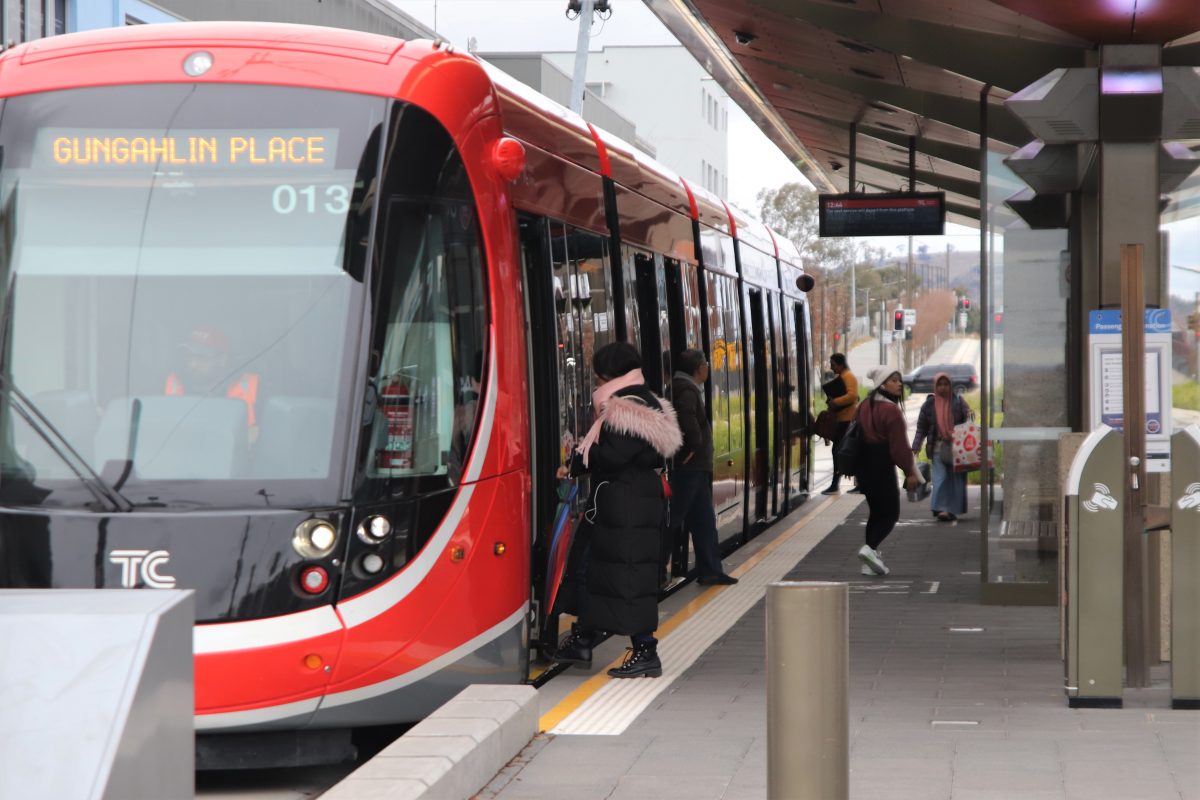
The Gungahlin light rail terminus. The report found multiple benefits for Gungahlin and the suburbs along the corridor to the city. Photo: Region.
Light rail Stage 1 has brought benefits to the Gungahlin-City corridor far beyond its public transport role, according to a new five-year analysis of the project from Transport Canberra.
Transport Minister Chris Steel said the report’s findings back the ACT Government’s decision to extend light rail to Woden and plan for future stages to other areas of Canberra.
The report will provide plenty of election-year ammunition for the government to use against the Canberra Liberals’ plans to abandon light rail after Stage 2A to Commonwealth Park and opt for an expanded electric bus fleet to meet Canberra’s public transport needs.
While the analysis found that light rail had increased public transport use and reduced congestion along the corridor, particularly on Northbourne Avenue, it also highlights the boost in construction, housing and business activity.
There have been 16.5 million passenger trips since the start of operations in 2019 and light rail now accounts for a fifth of all public transport patronage in Canberra.
In the first quarter of 2024, weekday average boardings were almost 14,000, and 7500 on weekends.
Almost all (99.98%) of services run on time and road-count data at high-use areas along the corridor reveal a significant fall in motor vehicle travel, including an 18 per cent reduction at the Northbourne Avenue and Macarthur Avenue intersection compared with 2016.
The analysis found that 43 per cent of passengers had never previously used the bus network, which the report says shows the power of light rail in attracting people to public transport.
The report says that increased interoperability between buses and light rail will further support growth across the wider public transport network with the upcoming roll-out of the new ticketing system, MyWay+.
It found that the project had been a catalyst for land releases and sales along the corridor and a spur for urban renewal and much-needed new housing.
Since 2016, $2.3 billion in construction has been given development approval or is currently under consideration in suburbs directly adjacent to light rail, and 6100 new dwellings have been built along the corridor.
This has also attracted new residents to the corridor, which has experienced a higher annual average population increase (4%) than the rest of the ACT (2.5%).

What light rail on Adelaide Avenue will look like. The government says the benefits enjoyed on Stage 1 can be replicated on Stages 2A and 2B to Woden and future lines. Image: ACT Government.
The analysis found that light rail had also boosted land values along the corridor.
The overall increase in the unimproved land value of blocks between 2011 and 2023 for non-unit residential more than doubled (113%, 25 percentage points higher than the average value across the ACT).
For residential units, it was 78 per cent, 10 percentage points higher than the average value across the ACT, and for commercial units, it was 49 per cent, 15 percentage points higher.
The analysis found that businesses had also made the light corridor home.
ABS data for the period 2020-22 show that the average net annual change in the number of businesses in the light rail corridor exceeded that for the rest of the ACT (8.6% compared to 6.5%).
The corridor also accounted for 23.9 per cent of the growth in employing businesses, with a net change of 1011 employing businesses between 2019 and 2022.
The analysis found business growth increased by 26.4 per cent in Gungahlin suburbs along the corridor from 2018 to 2022 and by 19.7 per cent in the city suburbs along the corridor over the same period.
In Gungahlin, there was a 31 per cent increase in the number of businesses from 2019 to June 2022 (592 to 773), although the report acknowledges that land releases and population growth also played a role.
Mr Steel said the report showed that Canberrans clearly preferred light rail, with more and more people choosing to live along the alignment.
“Our first mass-transit system, through the delivery of Stage 1 of light rail, represented a vision for Canberra as a connected, sustainable and vibrant city,” he said.
“The evidence outlined in this report realises that vision and supports our decision to deliver future stages of the project.”
Mr Steel said more areas of Canberra could look forward to the benefits revealed by the analysis with the construction and operation of future stages.
The City to Woden corridor would create a north-south public transport spine for Canberra that would continue to expand over the coming years, connecting Canberra’s key employment, residential and commercial hubs.
Mr Steel said there was a clear appetite from both business and the community to deliver a project that would provide thousands of local jobs, support the construction of more homes, remove congestion from roads and encourage more people to take public transport.
“We will continue to invest in this important city-shaping infrastructure that will benefit Canberrans for generations to come,” he said.





















